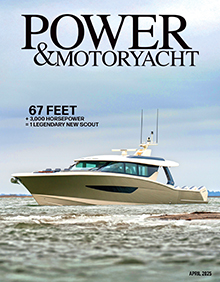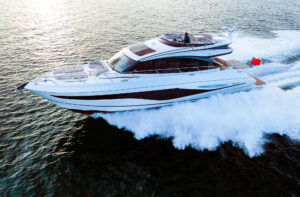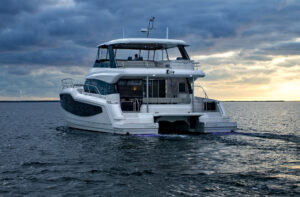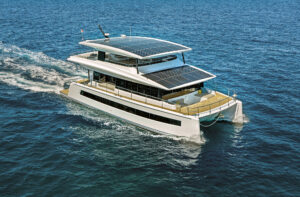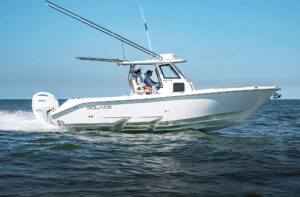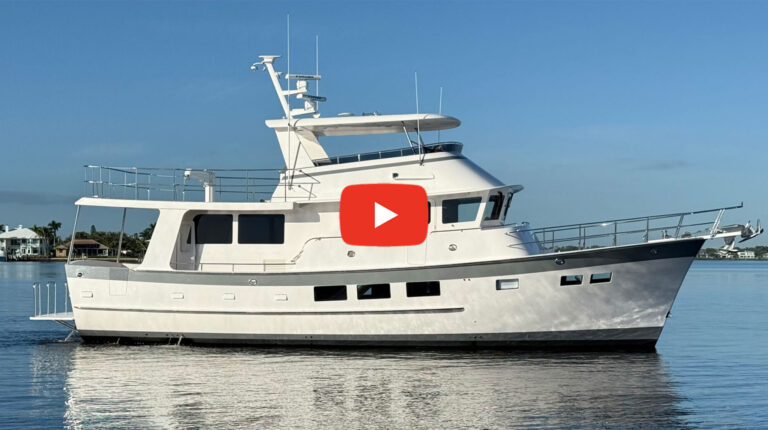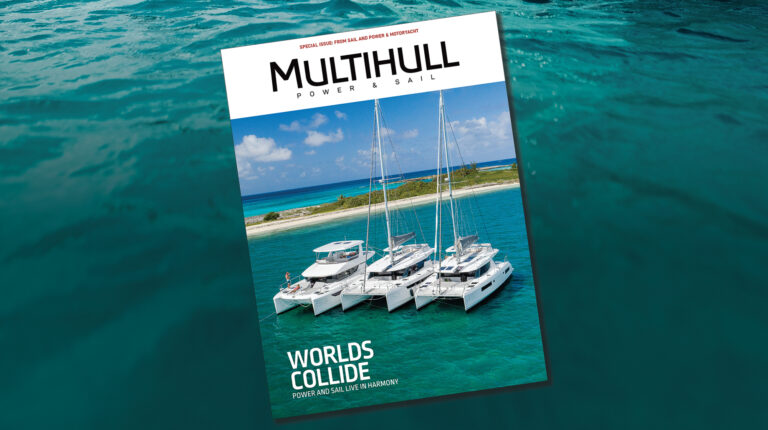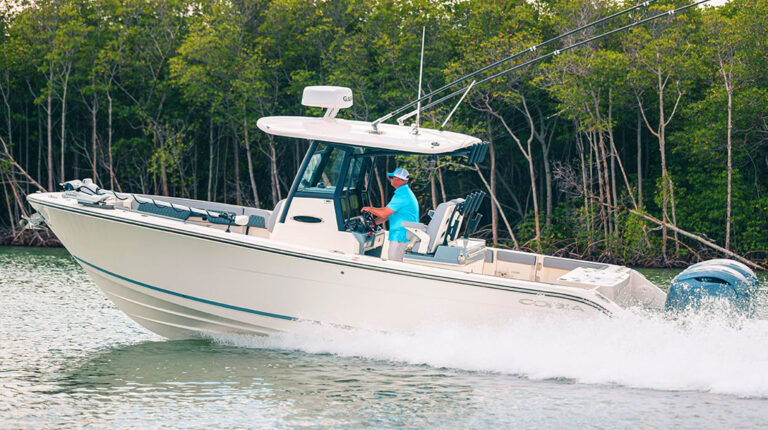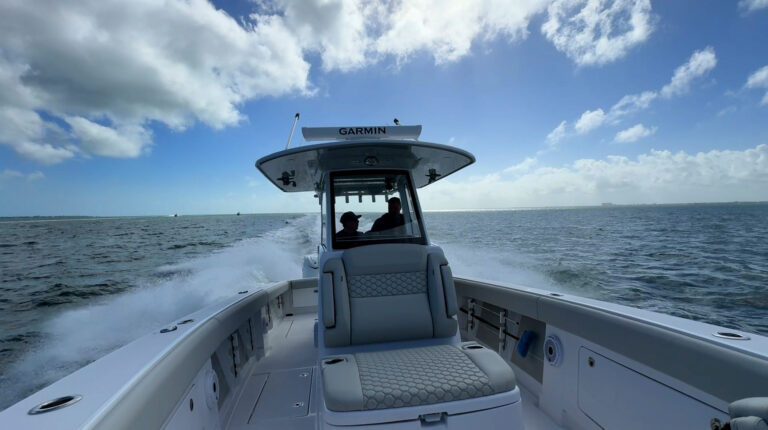A visit with Brazil’s largest builder, Schaefer Yachts, as it presses onward and upward into a fourth decade in business.
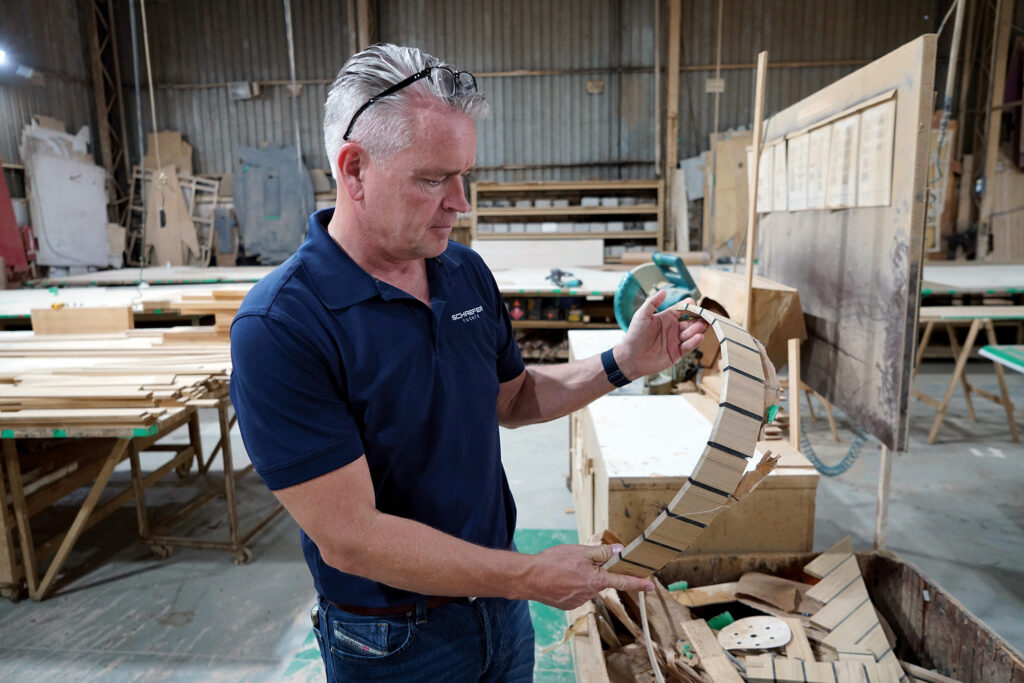
There’s a certain level of seaworthiness a true sailor brings with them when they go into the drawing room to design a boat. They know, more than anyone, that while propulsion helps, it’s the boat and not the motor that keeps you afloat.
Schaefer Yachts Founder Márcio Luz Schaefer had logged thousands of bluewater miles by cloth, racing and cruising in the South Atlantic, and he’d worked in numerous boatyards in his native Brazil before turning his interests to powerboats. Ultimately, the idea to design and build his own boats began in the early 1990s in São José, neighboring Schaefer Yachts’ current headquarters in Florianópolis. Starting out under the name Estaleiro Kiwi Boats, the 19-foot F6 became Schaefer’s first production model, the initial foray into the sport boat lineup of what is now Brazil’s largest powerboat manufacturer.
The first hull that would eventually bear the Schaefer Yachts moniker came along about 4 years later, with the Phantom 235, and then an ensuing series and advancements up to the Phantom 500HT (hardtop) and 500F (flybridge). These began as fairly modest builds for the era, but they were fast and they’ve been updated: Brazil’s Polícia Federal commissioned them with a pair of 578-horsepower Scanias for chasing down contraband.
Come 2006, Schaefer looked to newer technology and bigger and more updated facilities to form their structural components—hulls, stringers, decks and superstructures—with vacuum-infused resin. Structurally speaking, vacuum-infusing resin and cloth as opposed to hand-laying leaves fewer dry spots, voids and weakened bonds. Today, it’s a popular procedure that, when properly executed, results in a more complete resin infusion while reducing weight. It also reduces harmful VOC vapor effusion—something workers and the environment alike can appreciate. Schaefer Yachts was far from the first vacuum infusers, but it was an earlier adapter within the powerboat market.

Schaefer Yachts’ 20th anniversary saw a shift to larger boats: In 2013, the brand introduced their 830, the first 80-foot-plus production boat ever built in Brazil, and it ran until 2019 when they introduced the 81-foot 25M, which is still in production.
The next move for Schaefer was into smaller boats—the 375 dayboat is their current flagship—and a pair of center consoles—the V33 and V44—which have become the maker’s bread and butter. Today, 11 models are available in the U.S. under the Schaefer name, ranging from the V33 to the 25M, of which some 4,000 boats have been delivered.
When a builder sets its sights on the international market—especially one in a market as geographically isolated as Brazil—the proverbial big fish in a little pond suddenly finds itself outnumbered and outsized in new waters. Factor in that they’re entering an already flooded market? You might call the odds of success, let alone survival, slim. Further still, when you’re churning out a fraction—and in the shadow—of the most-sold sport- and pleasure-boat manufacturers on earth, you’re playing a game of David vs. Goliath.
But then being at the bottom of the world in Brazil has its advantages, too. Being situated in Florianópolis, Schaefer has a number of conditions to put their designs to the test. There’s short-period, wind-strewn chop inside the islands in the bays and large, long-period South Atlantic swells on the outside. In short, they see just about all the weather and sea states Poseidon can drum up, sometimes in the course of a day, as I did while visiting Schaefer’s facilities in December.
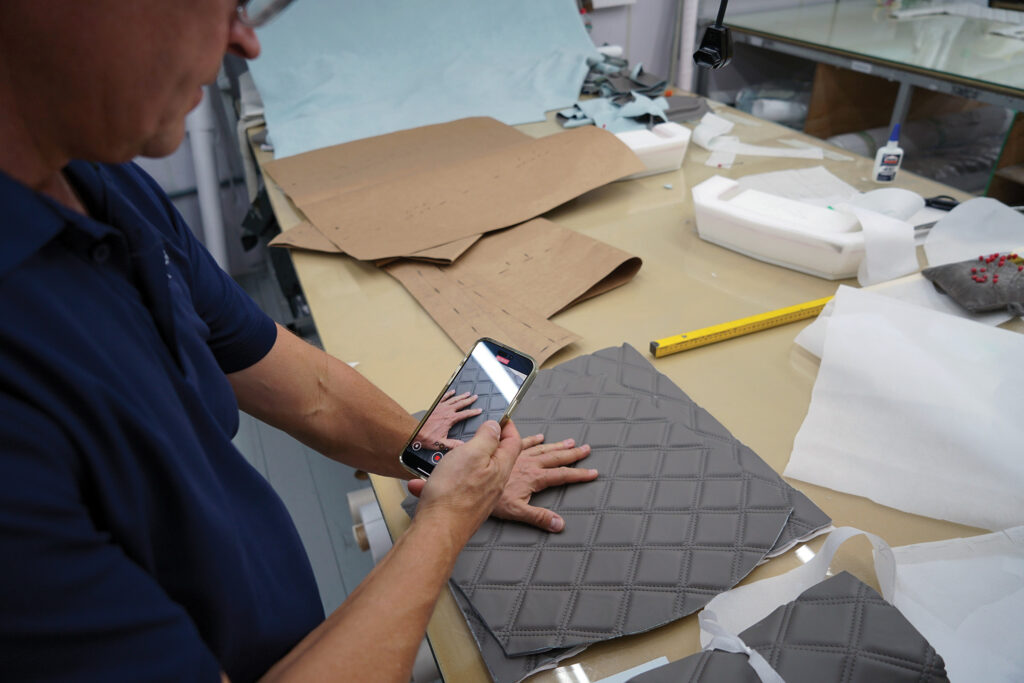
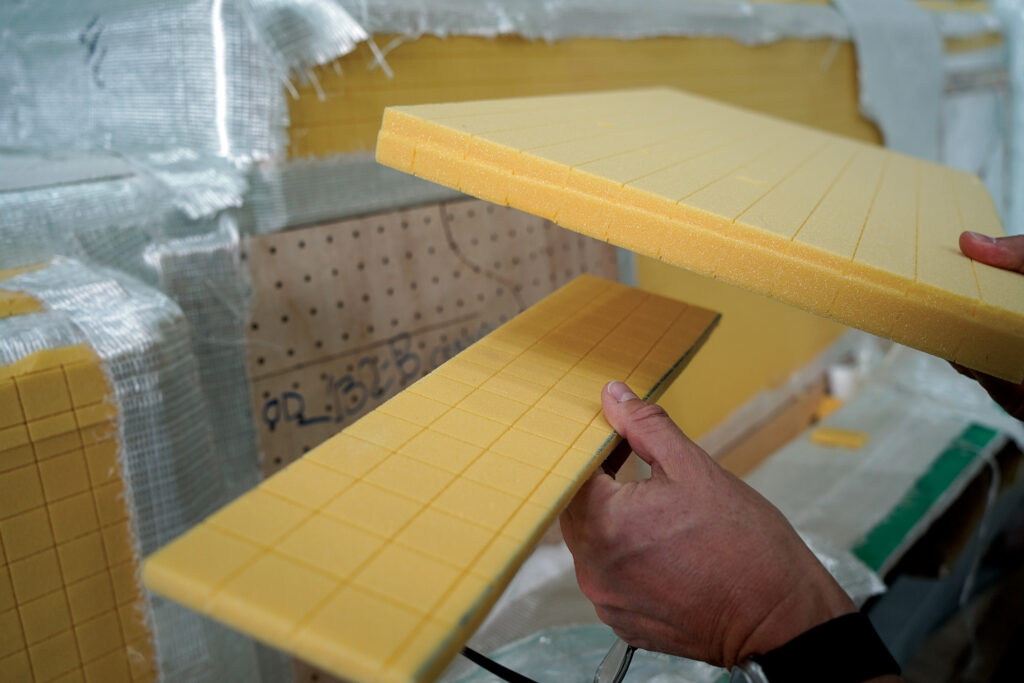
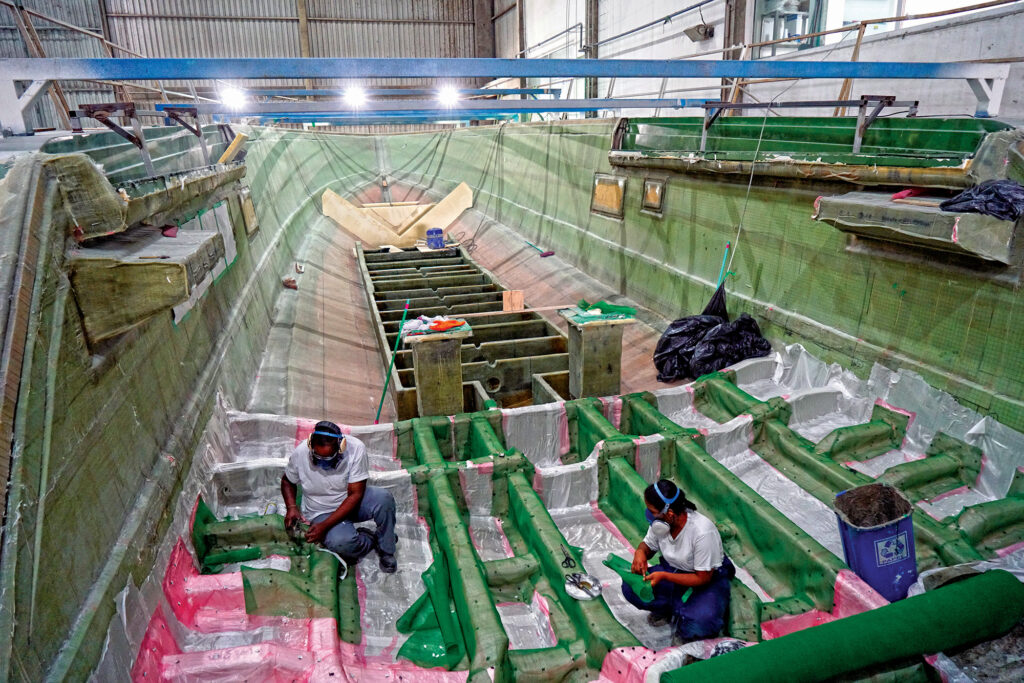
“When we test boats,” Schaefer’s CEO Nils Kah told me, standing bayside and facing an impending squall, “we obviously have the bay to both sides, but sometimes they expose different conditions. Actually, you had some yesterday, right?” he asks. Indeed, the geography in Florianópolis is dramatic, and reflected in the weather I experienced on board: A 25-knot sustained breeze with gusts into the 30s funneled through the narrows separating Baía Sul, and Baía Norte and Santa Catarina Island to the east. As I drove the builder’s V33 and 450 models, I was reminded of sailing in a gale beneath San Francisco’s Golden Gate. Florianópolis’s Hercílio Luz Bridge, a novelty at the time of its construction and still among the longest suspension bridges on earth, conjured a further sense of déjà vu. All of which is to say: It was howling.
“We have a short-period wind chop here,” Kah continued. “And then sometimes this side here”—Baía Sul—”is rather flat and the other side can churn up rather quickly. But then when we go around the island, the swells are coming in. It’s the Atlantic, after all, and the next land mass is basically South Africa. So sometimes like eight meters of swell to the point where—say you are going out on a 660, for example. It’s to the point where you see the boat and don’t see the boat, and see the boat and don’t see the boat. And then when the wind picks up, especially when it’s coming from the south, you get really nasty chop on top of that. And it changes quickly; within 20 minutes it can go from a nice day like what we have right now to the gnarliest situation you can imagine.”
Kah wasn’t exaggerating. Conditions flipped and flopped throughout the few days of my visit, and I could see potential for just about any and every combination you could dream of.
Beyond their geographical location, Schaefer Yachts has the benefit of existing within a relatively free market where labor remains affordable, yet still moderately regulated—there’s a reason Azimut, one of the largest yacht manufacturers in the world, has facilities a couple hours’ drive up the road. Another upside is some of the most affordable and (relatively) sustainable farmed teak on the planet is right at hand. Consider, too, that Schaefer owns and operates its own lumber mill within its facilities, making it all the easier to design and incorporate as much teak as anyone could want—down to, for example, shower grates—all in house. This enables picking and choosing materials and refine various designs at the drop of a hat where other builders couldn’t afford dreaming of doing so without passing the exorbitant expense onto buyers. From the molds to the layups and the decks and superstructures to the upholstery, Schaefer does almost everything in house, save for certain fittings and finishings. This not only simplifies and streamlines the process but makes myriad customizations possible; a variety of hull and interior colors and schemes are available where other builders might find such requests laughable.
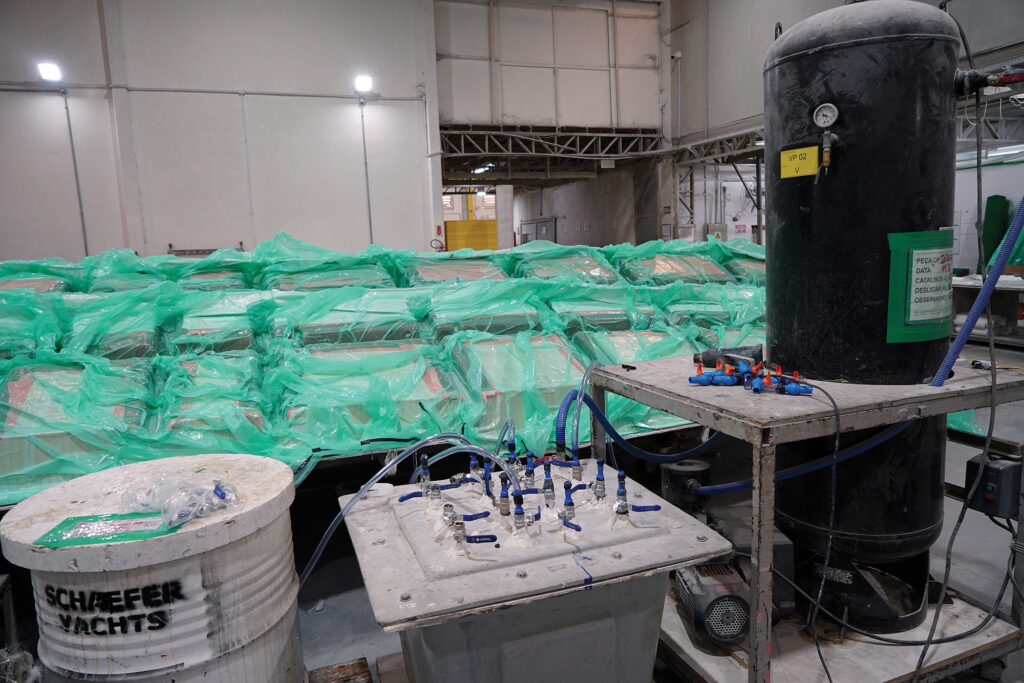
Another advantage of that nearly full in-house production? Schaefer’s roughly 700 employees manage to turn out about 130 boats a year and that’s between a pair of small, thriftily-organized factories keeping no more than two dozen boats in build at once. The larger, older factory was established in 2010 in a predominantly industrial area in Palhoça. It contains the bulk of Schaefer’s productions, including sub-66-foot builds as well as the teak factory and the upholstery shop. Winding my way through, I was impressed to find a masseuse making the rounds with a massage gun and spending several minutes working out knots and cracking jokes with the couple dozen workers (predominantly women) stationed at sewing machines. The second, smaller facility, which doubles as a showroom, is majestically perched beneath the Hercílio Luz Bridge on the Santa Catarina Island side in a somewhat hip little enclave you might mistake for Brooklyn, but looking west, you see the Florianópolis cityscape. The larger boats are built here, and the finishing touches and testing of many of the smaller builds take place here, too.
Looking forward, Kah says the company is focused on establishing itself in the sub-40-foot and center-console market. Anyone who’s been to an international boat show or flipped through this magazine within the last couple of years is well aware of a trend toward sport boats. At the heart of that movement is the center console designed primarily for entertaining but with just enough fishing flair to make it fishable. This is easier said than done and it’d be hard to say whether any one builder has pulled ahead within the trend. Where Schaefer stands out on this front is in offering a somewhat modular package. For example, at the transom on their V33, where a dinette and a pair of settees are normally stationed will be a livewell with a fold-down bench seat facing forward and, in the middle of the deck, a deckplate and receiver for an interchangeable pared-down table and a dive-tank rack setup. It’s a somewhat novel concept in modularity—the electric-boat company X Shore offers similar modules—but a buyer should keep in mind storage space for these switchable stations.
Apart from the removal of the settees and large dinette—which otherwise fold out into one enormous sunpad—the fisher-friendly option of the V33 will also forgo the teak deck for finished fiberglass—something anyone who’s swabbed decks after a day of fishing will not only appreciate, but require.
Of course, no pleasure boat/fishing boat crossover comes without its concessions. The large, rearward-raked windshield doesn’t brandish the traditional supportive hardware found on fishier, more utilitarian boats, opting for a bare, luxe look that leaves a gap between windshield and T-top and not much to grab onto. A cover snaps and zips on in a spell of weather, but it’s not something most anglers (or boaters) would be particularly accustomed to or willing to deploy—though it’s a good option to have if you’re running home with a family who wants to stay warm and dry. Some slight redesign with a bit of steel and a tighter fit would go a long way with the fishing crowd, but that could lose some sportster-hungry eyes in the process—again, concessions. Forward of the helm is a sunpad fit for two. While the deck is single-level and offers full walkaround access with high freeboard all around as well, I wouldn’t call the bow particularly fisher-friendly, especially if someone happens to be lounging there, but all things considered it is a serviceable casting platform—something that can’t be said of other boats spearheading this trend.
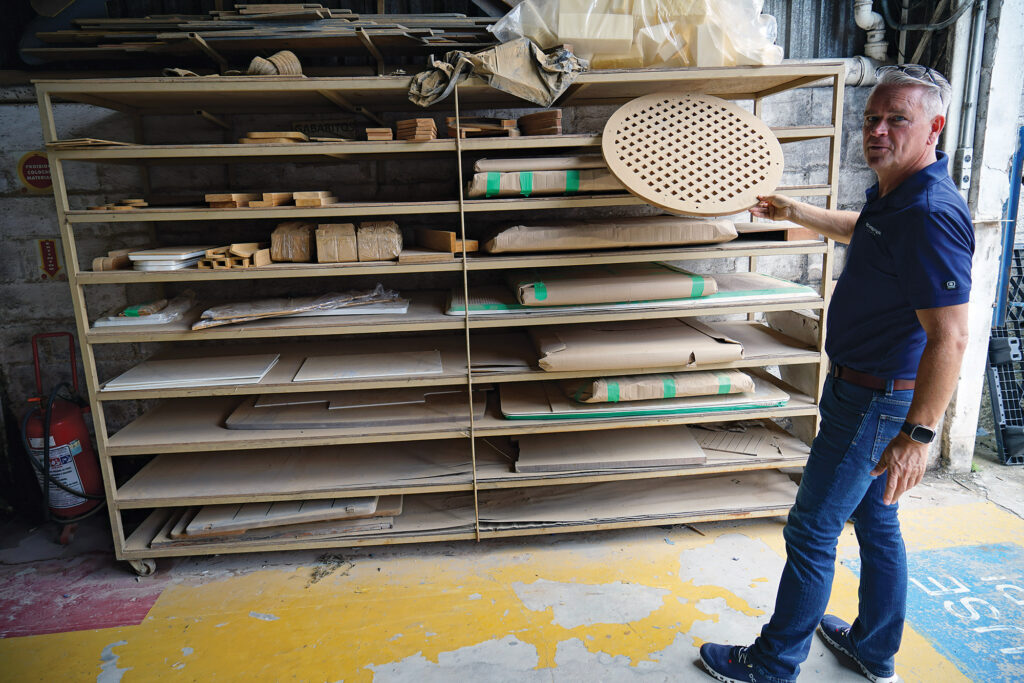
On the subject of the pointy end of Schaefer’s center-console models, while both the V33 and the larger and V44 dayboat offer a dry ride, it’s tough to say whether their à la mode plumb bows perform any favors below the waterline. Time and again, as we’ve written in this magazine, plumb bows fall in and out of fashion in a cyclical nature, once serving motor vessels of yore by maximizing waterline length and optimizing displacement speeds.
But that axe-shaped bow does expand the V-berth, and keeps the foredeck freeboard high, which lends extra safety. For what it’s worth, I’ve yet to see a crossover boat along these lines with a seriously fishable bow; the comfort seating has to go somewhere and that place always seems to be the bow. Again, everything is a tradeoff, and the perfect crossover fishing boat will almost surely never exist. But hat tips are due with the V33, where progressions have been forged, especially when a center console’s space is at a premium.
The market makes demands, and it’s a builder’s job to heed the call. The idea for Schaefer Yachts, being a pleasure-boat builder first, is to bring (and keep) non-anglers aboard while finding ways of appeasing the fishing crowd, not vice-versa. The galley amidships makes for a perfect entertaining center while, again, still passing for a light-duty rigging station. Down below is a V-berth with just enough space and storage for an overnight or two for a couple, and the head is impressively capacious for a 33-foot center console. I’d venture that this boat addresses both ends and should entice recreational anglers and pleasure cruisers alike. You might call that a feat.
When it comes to power across its lineup, Schaefer makes a point of offering numerous options. Where some builders might accommodate a handful of different engine configurations, it makes Volvo IPS standard in most boats, but also V-drives, straight-shafts and surface-piercing drive engines in some models. “At one point,” Kah told me while driving between factories in Florianópolis, “we had a boat that had 26 different engine options.” Kah quickly turned the subject to the late-model BMW in which we were taxiing, discussing the finer points of the engine under the hood and all of its options. Most of that car talk was lost on me, but then I could imagine that Kah might have had no small part in pressing Mr. Schaefer to offer so many different power packages with each model—a benefit probably not lost on the go-fast crowd.
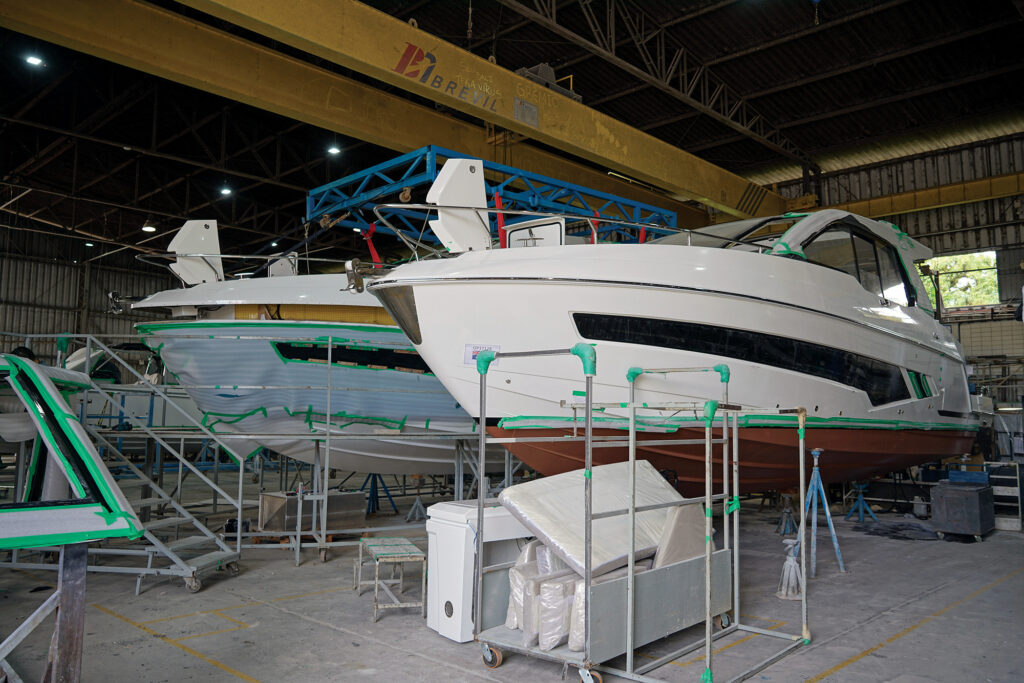
The majority of Schaefer’s boats are sold in Brazil and South America, with the balance going primarily to the U.S., Europe and as of 2022, Australia. Almost all of its boats are built to order and competition will be tight as it ventures further into the global market. Many in the industry compare Schaefer’s cabin-festooned hulls to Sea Ray’s Sundancer line—the Sundancer 370 to Schaefer’s 375 comparison is particularly hard to ignore. The profiles of the boats and their layup processes are similar. Granted, Kah repeatedly pointed to inner and outer liners on superstructures where the competition often foregoes the extra fiberglass and resin for more cost-efficient paneling, often plywood, or nothing at all.
And while Sea Ray might offer better fittings and more cabin space, that comes at the cost of topside space and, well, cost itself. The 2024 370 Sundancer will run you upwards of $1 million with all the options. A Schaefer 375 starts at $600,000 and tops out at $800,000 with full options and a teak deck to answer for Sea Ray’s finished fiberglass and EVA foam decking. Some of us drool over teak decks—and take the time to oil and care for them. Others would just as soon avoid the fuss and go for the finished glass and EVA. The Brazilian manufacturer comes away with something of a yachtier appeal compared to Sea Ray’s approach. Not to disparage one or the other; the powerboating world takes all kinds, after all.
Regardless of the competition abroad, Mr. Schaefer and co. know they have their work cut out for them as they evolve and venture farther abroad. But haven’t they always? Be it at home or in the U.S., the market is ever shifting. Schaefer’s nearly 33 years into the game, and that hasn’t stopped them yet.

